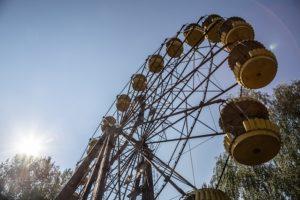When the Chernobyl nuclear reactor melted down in 1986, most people believed that the fallout zone would remain deserted for hundreds if not thousands of years. What they found instead is not only a thriving ecosystem, but also plenty of clean energy potential.
The majority of animals within the exclusion zone have thrived without human interaction. Most notably, the native wolf population within this radioactive zone is nearly seven times higher than the surrounding areas. Though this wildlife does test positive for radioactivity, there have not been any notable mutations since the first few years after the disaster.
The only notable lowering of population seems to be through human poaching. The 18.6 mile radius may be treated as a nature preserve, but it isn’t completely protected by preservation laws.
Adding to this new life, a joint venture between Ukraine and German companies have brought a solar farm to the now defunct power plant.
Currently the farm, which opened just a few days ago, is producing 1 MW of energy but they plan on expanding that production to 100 MW by the end of it’s development.
Ukraine has had steadily rising energy prices and this new solar farm looks to help lower them. The country has had energy issues since the annexation of Crimea in 2014. There were 140 MW of energy production that Ukraine had in Crimea, but now their energy needs have become dependent on Russian natural gas and oil.
This new site in Chernobyl isn’t just energy production, it is the next step in Ukraine becoming more independent.
Want to learn more about the history of Chernobyl? Here’s a short video on the cleanup efforts that are currently underway. Here is another about the animals in the area that are thriving in the radioactive landscape.
Become a part of the green energy movement! Contact us to find out your solar potential.

